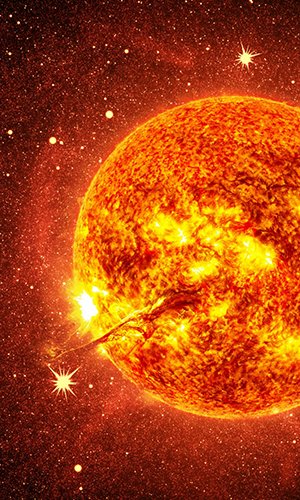In reply to the question “When does summer start?” most likely you would answer that it begins on the day of the summer solstice, which this year falls on 20 June. But a meteorologist might say it already started a while ago, and more precisely on 1 June. Who is right? Both answers are correct, because you should know that there is no unique definition of summer. In fact, we talk about the meteorological summer when we base it on temperatures: the meteorological summercoincides with the hottest quarter of the year, which corresponds at our latitudes to the months of June, July and August. If, on the other hand, we refer to the position of the Earth with respect to the Sun, then we speak of astronomical summer, which starts with the summer solstice and ends with the autumn equinox. This year, the astronomical summer will start on Monday, 20 June,at 22:51 UTC, when the hours of light will reach the maximum duration and the Sun will touch the highest point with respect to our horizon. From 21 June, the peak of the Sun will then begin to increasingly move southwards and the days, which until now have gradually lengthened, will start to shorten again until 21 December, the date of the winter solstice which, at our latitudes (northern hemisphere), is the shortest day of the year and the start of the astronomical winter. Not forgetting the autumn equinox, which falls on 22 September, the date on which night and the day will have the same duration. The opposite happens in the southern hemisphere: infact, the cycle of the seasons of one hemisphere is the opposite of that of the other; when it is summer in the northern hemisphere it is winter in the southern hemisphere and when it is spring in the northern hemisphere it is autumn in the southern hemisphere.
Solstices, equinoxes and the changing of the seasons
Solstices and equinoxes are due to the trajectory with which our planet orbits around the Sun.. The axis of rotation of the Earth and the orbit plane are in fact not perpendicular, but meet at an angle of approx. 23.27 degrees. This gives rise to the apparent motion of the Sun in the sky during the course of the year and causes day and night to have of different durations throughout the year and the seasons to change. Spring starts with the spring equinox (which falls between 20 and 21 March), when day and night are the same length, and ends with the summer solstice, which falls between 20 and 21 June and signals the start of summer. On this day there is the greatest number of hours of light, because the Sun is highest on the horizon. The autumn equinox is exactly half way (22-23 September) towards winter which starts on the darkest day of the year, which falls on 20 and 21 December. The seasons do not always have the same numberof days since they start and finish in very specific astronomical moments, which vary from year to year. Every year, in fact, the solstices and equinoxes are delayed by approx. six hours: every year the Earth takes a little more than a year to revolve around the Sun, exactly 365 days and 6 hours. So, to return to the same point of the orbit (in this case that of the solstice or equinox) every year it takes approx. 6 hours more which, however, are recovered every 4 years with a leap day. And that explains why solstices and equinoxes do not always fall on the same day of the year.
Solstices and pagan rituals
For millennia the summer solstice represented a special day for many civilizations of the past. It is believed, for example, that among the reasons that led to the construction of the Stonehenge circle of stones was precisely that of paying homage and studying the solstices and equinoxes, and that the arrangement of the stones was designed to align with the first sunlight of the day of the summer solstice.It was apparently precisely the importance of the date for pagan civilizations which caused the choice of 24 June as the date of birth of St. John the Baptist (exactly six months after Jesus Christ, born to coincide with the winter solstice), so as to bring the celebrations within the context of the Christian faith. The solstice, as Midsummer's Day (celebrated on days ranging from 21 to 25) is also still an important holiday in many European countries, such as Sweden (where it was thought in the past to officially make it the nation's national holiday), Romania, Poland, Ukraine, the United Kingdom, Spain, Portugal and Greece. In short, only in Italy is the summer solstice, or the feast of St. John the Baptist, whatever you want to call it, of little importance, since we prefer to celebrate summer in the middle of August.




